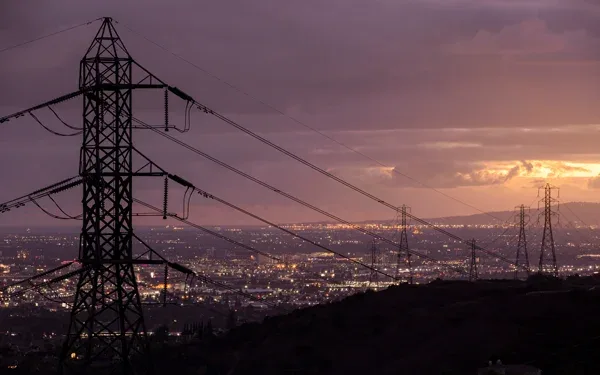Offshore wind could boost California’s transition towards clean-energy future
In May of 2021, the vision for California’s clean-energy future came more sharply into focus when Gov. Gavin Newsom and the administration of President Joe Biden announced an agreement to open the deep ocean waters off the state’s coast to floating offshore wind development for the first time. With California energy policy committed to a carbon-free electrical grid by 2045, offshore wind is now seen as a key piece of the state’s long-term energy strategy.
“California is fortunate to have one of the best offshore wind resources in the world, capable of generating clean electricity around the clock to help California transition away from fossil fuel-based energy as quickly as possible while ensuring grid reliability,” David Hochschild, chair of the California Energy Commission (CEC), said.
Developing utility scale floating wind energy off the California coast is projected to be eight to ten years away, but Gov. Gavin Newsom’s office, the California Legislature, state energy agencies, the California ISO, and the U.S. Bureau of Ocean Energy Management (BOEM) have been busy on a variety of fronts to make utility scale floating offshore wind projects operational as soon as feasibly possible.
Just a few months after the agreement with the federal government was announced, Newsom signed Assembly Bill 525, sponsored by former Assemblyman David Chiu of San Francisco. Among other things, the legislation requires the CEC to “evaluate and quantify the maximum feasible capacity of offshore wind to achieve reliability, ratepayer, employment, and decarbonization benefits and to establish megawatt offshore wind planning goals for 2030 and 2045. In establishing those goals, the bill specifies 12 different factors that the CEC is to consider.
The CEC has held three public workshops on the issue since March. Its preliminary planning goals were 3 gigawatts (GW) of offshore wind for 2030 and 10 to 15 GW for 2045. Public commenters at a May 18 workshop, citing newly released studies that were not available during development of the CEC’s draft report published May 6, suggested planning goals that start with 5 GW in 2030 and 20 to 50 GW in 2045.
Gov. Newsom has also come out in favor of a higher planning goal, spelled out in a July 22 letter to Liane Randolph, chair of the California Air Resources Board. “California is in the midst of a climate crisis . . . ,” the governor wrote. “Now, because of the severity of the impacts California faces, we need to up our game.”
Newsom went on to write: “That’s why I am asking the California Energy Commission to establish a planning goal of at least 20 GW by 2045 in the AB 525 process, and to work with our federal partners to accelerate the deployment of offshore wind for the needs of all those who use and care about California’s precious coastal resources.” On August 1, the CEC posted on its website a revised final report with new planning goals of 2 to 5 GW for 2030 and 25 GW for 2045. The full Commission is scheduled to consider the report at its business meeting this Wednesday, Aug. 10.
“These preliminary planning goals are designed to be potentially achievable but aspirational and are established at levels that can contribute significantly to achieving California’s climate goals,” the CEC’s revised report said.
Planning for the development of floating offshore wind resources is just one piece of the puzzle, however. There is also significant transmission infrastructure needed to move the wind generation from offshore floating turbines to where it can be used to power homes and businesses. And transmission planning, analysis and approval are core ISO responsibilities, which is why AB 525 directs the CEC to consult with the ISO and California Public Utilities Commission in developing transmission pathways for offshore wind energy development.

“We studied the transmission needs for offshore wind in the ISO’s 2021-2022 transmission planning process and in our 20-Year Transmission Outlook,” said Neil Millar, ISO vice president for Infrastructure and Operations Planning. “The ISO will continue to develop the studies and transmission needs in our transmission planning process to meet the state’s policy and goals. We look forward to continue working with the CEC and the California Public Utilities Commission to do all we can to help the state meet its resource and clean energy goals.”
In identifying locations off the California coast to determine the level of commercial interest in wind energy leases, BOEM issues a Call for Information and Nominations for three areas off the California coast: Humboldt on the North Coast and Morro Bay and Diablo Canyon off the Central Coast.
“The North Coast wind resource is one of the best in the world with high renewable energy potential and wind speeds consistent and favorable for commercial development,” the CEC’s offshore wind energy report said. “But the electric system in California’s North Coast region is relatively isolated from the California grid and serves primarily local community need. Additional transmission infrastructure will be needed to deliver offshore wind energy from this region to the grid.”

Existing transmission on the Central Coast is robust and near large load centers, the report continued, so there could be opportunities to use some of the existing infrastructure, but there is still a need for long-term infrastructure planning.
Also in May 2022, BOEM released a proposed sale notice for public comment for three possible lease areas in the Morro Bay Wind Energy Area and two more in the Humboldt Wind Energy Area. BOEM estimates that the 5 lease areas could accommodate 4.5 GW of floating offshore wind energy and power more than 1.5 million average U.S. homes.
During his presentation at the CEC’s June 27 workshop, Jeffrey Billinton, the ISO’s director of Transmission Infrastructure Planning, provided overviews of ISO transmission studies for the different offshore areas under consideration.
For offshore wind resources on the Central Coast, the ISO study concurred that some existing transmission lines could be used. In the North Coast area, “significant” 500 kV and HVDC facilities would be needed to interconnect to the existing 500 kV system to integrate offshore wind into the ISO grid.
In the North Coast area, the ISO identified three alternatives to connect projects from the Humboldt Wind Energy Area totaling approximately 1,600 MW. These alternatives included 1) two 500-kV AC lines connecting to the Fern Road 500 kV substation with an additional 500-kV line from Fern Road to Vaca Dixon substation; 2) a HVDC LLC line to the Collinsville 500/230 kV substation that could either be overhead or a subsea cable; and 3) a HVDC VSC subsea cable to a new station referred to as Bay hub located in the Greater Bay Area with 230 kV lines to existing 230 kV stations in the area.
One of these alternatives would interconnect the initial Humboldt call area, with a hybrid of the alternatives being required as the capacity of offshore wind from other North Coast call areas develops. The alternative to interconnect the Humboldt area would be selected based upon the capacity, timing and sequence of the offshore wind to be planned for the North Coast.
The CEC has been taking other steps to prepare for floating offshore wind development and fulfill several other requirements in AB 525. Under terms of the legislation, CEC staff are working on a preliminary assessment of the economic benefits as they relate to seaport investments and workforce development needs as well as a permitting roadmap, both due by December 31, 2022. These will support development of the Strategic Plan for wind energy off the California coast in federal waters, which the legislation calls for no later than June 30, 2023.
To help prepare for California’s floating offshore wind future, the CEC has also approved a $10.5 million grant to support the Humboldt Bay, Harbor, Recreation, and Conservation District’s efforts to develop a heavy-lift marine terminal in the bay. Such a terminal will help enable the district to handle heavy loads, along with the manufacture, assembly, and, decommissioning of offshore wind turbines and floating platforms.
Like any emerging technology, building and managing offshore wind in California comes with challenges. Wind turbines developed in oceans around the globe and off the East Coast have been installed in shallow waters and affixed directly to the seabed. In the Pacific Ocean off California’s coast, deeper water requires construction of floating platforms attached to mooring lines and affixed to anchors in the seabed. Environmental, financial, and other concerns will also need to be addressed. Still, offshore wind projects have been surging around much of the world, with the United Kingdom and China the most active nations.
“Developing offshore wind to produce clean, renewable energy could be a game changer to achieving California’s clean energy goals and addressing climate change – all while bolstering the economy and creating new jobs,” Newsom said when the deal with the Biden administration was reached last year. “This historic announcement, which could provide clean power for up to 1.6 million homes over the next decade, represents the innovative approach we need for a clean energy economy that protects the coasts, fisheries, marine life and Tribal and cultural resources we value so much as Californians.”


